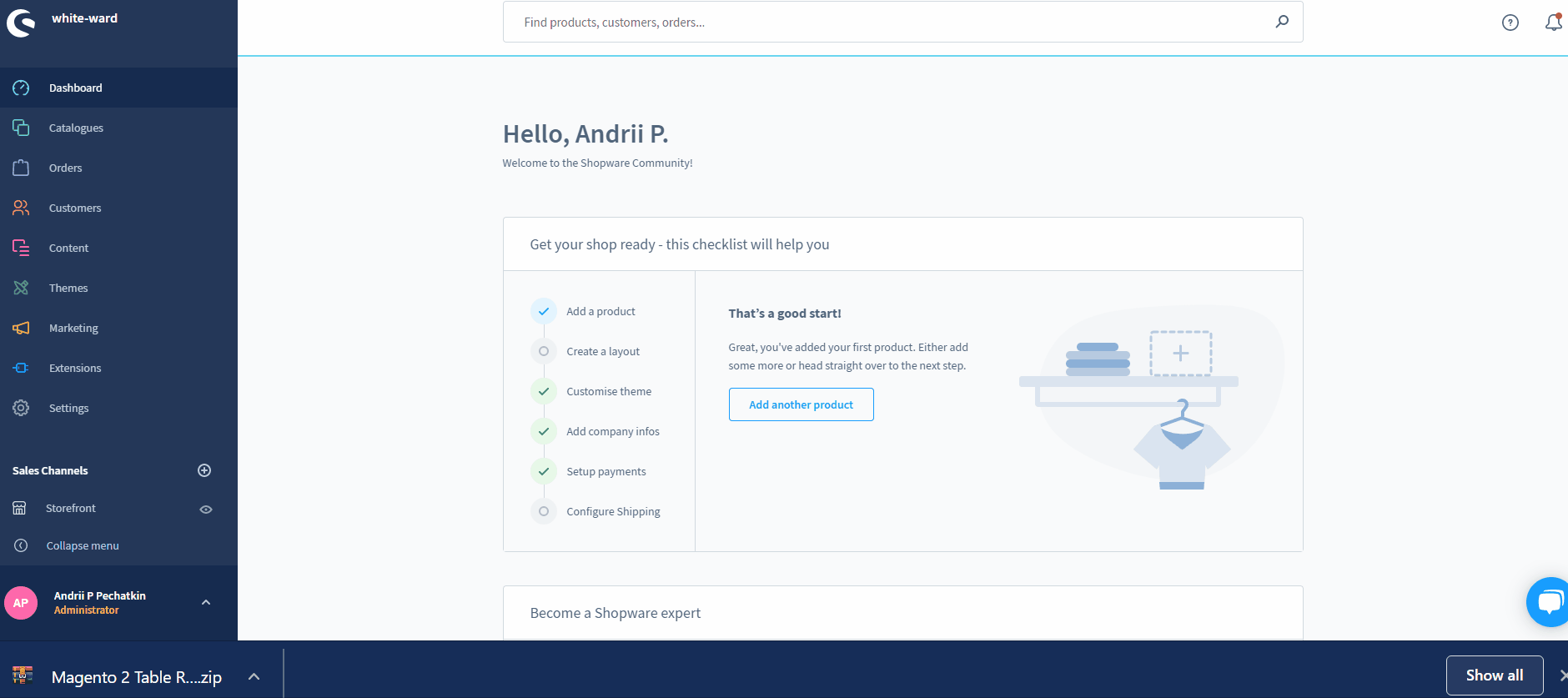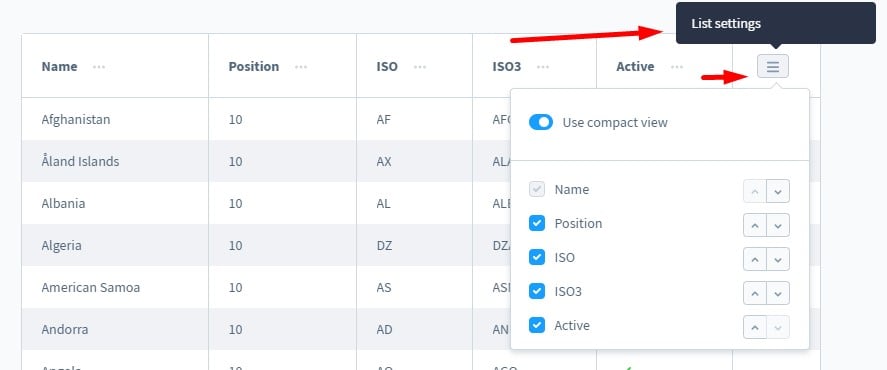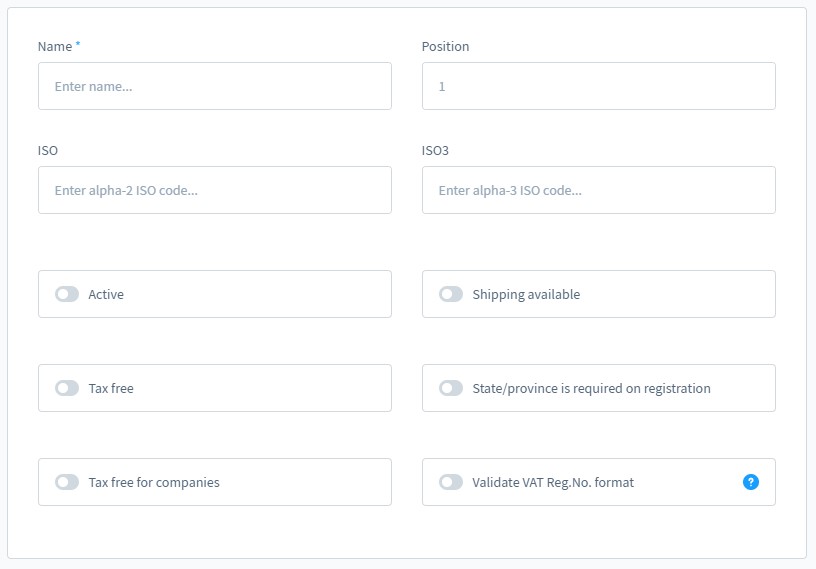Exploring Shopware: Countries in Shopware 6

Shopware 6 lets you add numerous countries to your e-commerce storefront. By default, the system offers a huge list to choose from. You can edit any record in it as well as add new ones. In the following article, we explore the Shopware 6 countries screen, describing its nuances. You will learn how to manage countries in Shopware 6, edit the related information, add new records, and delete the data that is already available there. We also touch upon the topic of importing country data to Shopware 6.

Note that we provide Shopware integration with external platforms. Contact our support for further information or try our Improved Import & Export Extension for Shopware.
Table of contents
- 1 Country Settings in Shopware 6 Admin
- 2 Shopware 6 Countries Overview
- 3 How to Create A New Country in Shopware 6
- 4 How to Import Country Data to Shopware 6
- 5 Shopware 6 Country Settings FAQ
- 6 Shopware 6 Essentials FAQ
- 6.1 How to create a Shopware ID?
- 6.2 How to create a Shopware account?
- 6.3 What is Shopware master data?
- 6.4 How to add a shop in Shopware?
- 6.5 How to add a payment method to your Shopware account?
- 6.6 How to create a deposit in Shopware?
- 6.7 How to purchase Shopware extensions?
- 6.8 How to get support in Shopware?
- 6.9 How to migrate to Shopware 6?
- 6.10 How to automate import and export processes in Shopware 6?
- 6.11 How to integrate Shopware 6 with external systems?
Country Settings in Shopware 6 Admin
The Countries screen is situated in the primary settings section of your administration. You can find Shopware 6 Country Settings as follows:
- Go to your Shopware 6 administration;
- Open its main menu;
- Proceed to the Settings section;
- Open the Shop subsection;
- Hit the Countries button.

Shopware 6 Countries Overview
The Shopware 6 Countries overview contains all configured countries available in your sales channels. The corresponding screen looks as follows:

The top row displays the number of available countries, lets you switch between languages, and add new countries to the list.

As for the grid, it displays the configured countries, their position in the list, and country-code according to ISO 3166 and ISO3.
Besides, there is the Active column that displays enabled/disabled countries. As for the List Settings column, it contains a context menu that lets you edit or delete the existing countries.

Also, the List Settings button lets you rearrange the order of columns as well as show/hide them and switch to the compact view.

How to Create A New Country in Shopware 6
Hit the Add country button to create a new country in Shopware 6.

The system redirects you to a new screen divided into the following two sections: Settings and State/Province. The first one looks as follows:

- Name – enter the name of your new country here;
- Position – specify the country position in this row;
- ISO and ISO3 – type country codes;
- Active – enable/disable your country;
- Shipping available – enable/disable shipping for the country;
- Tax-free – offer tax-free deliveries to the country;
- State/province is required on registration – require a state/province to be specified for a country;
- Tax-free for companies – specify whether the prices for companies should be displayed tax-free;
- Validate VAT Reg.No. format – activate a check of the VAT ID format for the EU countries.
Note that this information must be entered in the system-defined default language.
When adding a new state/province, click the Add states/province button in the second section of the configuration screen.

You will see the following pop-up window:

Assign the state/province name, ISO code, and position. The language condition is still required: use the system-defined default language.
How to Import Country Data to Shopware 6
If you need to import country data to your Shopware 6 website, our team can help you simplify and automate various processes associated with this procedure. Try our to achieve your goal. You can use it to import any entity to Shopware 6. The module provides the ability to create cron-based schedules and mapping schemes to automate data transfers. The first instrument provides the extension with the ability to launch import and export processes without interaction on the admin side. The second instrument lets you map all the imported data to the corresponding places in the database of your website. Please, contact our support before using the extension. We will help you get the most out of it.
Shopware 6 Country Settings FAQ
How to find Countries in Shopware 6 administration?
You can find the countries of your shop under Settings -> Shop -> Countries.
How to add new countries in Shopware 6?
Hit the Add country button to add a new country in Shopware 6. Next, provide the necessary information as shown above.
How to edit a country in Shopware 6?
Go to Settings -> Shop -> Countries and use the context menu on the Countries screen to edit a country.
How to delete a country in Shopware 6?
Go to Settings -> Shop -> Countries and use the context menu on the Countries screen to delete a country.
How to add a state/province in Shopware 6?
Go to Settings -> Shop -> Countries, add a new country or edit the existing one, hit the Add states/province button in the second section of the configuration screen to create a new state/province. Note that it is possible to add numerous states.
Shopware 6 Essentials FAQ
How to create a Shopware ID?
There is no special procedure for creating a ShopwareID. You get it automatically while creating a Shopware account.
How to create a Shopware account?
Go to a registration page, click the Register Now link, and fill in the form to create a shopware account. Next, follow the instructions provided in a confirmation email. Complete the registration, providing additional information.
What is Shopware master data?
Shopware master data is all the information required for your Shopware account. It consists of various company details, such as addresses, phone numbers, emails, etc.
How to add a shop in Shopware?
You can add a Shopware shop in a merchant area after clicking the corresponding link on the start screen’s right part. Choose a type of your new shop: a cloud storefront or an on-premise installation. After that, it is necessary to provide more information and save changes.
How to add a payment method to your Shopware account?
It is possible to configure a payment method under Basic Information -> Accounting. You can select PayPal, credit card, or direct debit and use it to add a deposit for purchasing various tools for your e-commerce website.
How to create a deposit in Shopware?
Shopware lets you add a deposit to your shop under Merchant Area -> Shops. Choose a storefront to provide funds to and hit Open Account Details. Add a deposit that would cover the minimum purchase amount.
How to purchase Shopware extensions?
With a minimal deposit on your account, you can use either Shopware Marketplace or Plugin Manager to buy extensions and themes. Choose all the necessary tools and complete the purchase.
How to get support in Shopware?
You can discuss questions regarding your account or license here: info@shopware.com and +49 2555 9288 50. Use financial.services@shopware.com and +49 2555 9288 510 to send inquiries regarding accounting and financial services.
How to migrate to Shopware 6?
The Improved Import & Export extension is developed to assist you with the migration to Shopware 6. It offers lots of benefits over the default tools, such as cron-based schedules and mapping schemes. You can use our module to transfer core entities to your new website from any external system. Besides, it lets you migrate from Shopware’s previous versions. And with the export solutions for other e-commerce platforms, you can easily transfer data from Magento, Shopify, and other systems to Shopware 6. Contact our team for more information.
How to automate import and export processes in Shopware 6?
Automation of recurring data transfers is another purpose of the Improved Import & Export extension for Shopware 6. It simplifies regular data updates providing the ability to create a schedule of import and export processes per each data transfer. As a result, you can launch the corresponding procedure according to the specified time frames with no interaction on the admin side.
How to integrate Shopware 6 with external systems?
The Improved Import & Export extension is also responsible for the integration with ERPs, CRMs, accounting tools, and systems. The module automates repetitive import and export processes with cron-based schedules and modifies data according to the requirements of your Shopware store with mapping presets, which also work in the export direction.









